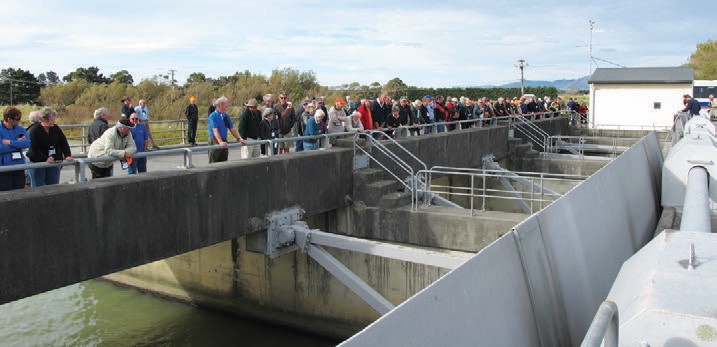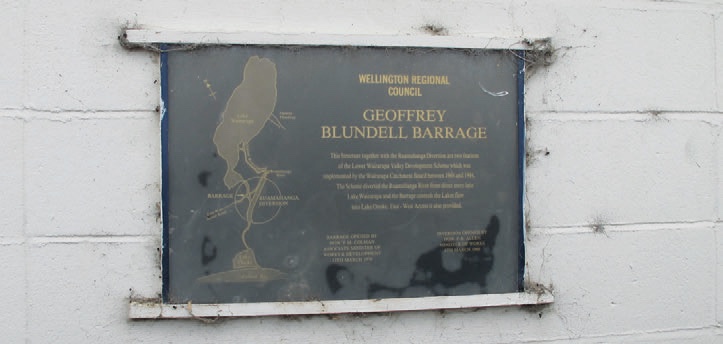The barrage gates
Jenny Brodie, New Zealand Tree Grower August 2011.
From Pirinoa Station, the next visit was to view the barrage gates, an integral part of the Lower Wairarapa Valley Development Scheme. Earlier in the day during lunch at the Pirinoa Hall, we were treated to a viewing of a historic film of the early stages in the scheme, its history and purpose. This made the visit to the gates all the more pertinent.
Although the rich, alluvial lower Wairarapa river valley was settled as early as the 1840s, it was always subject to regular flooding causing livestock losses, especially every winter. It brought uncertainty for those trying to live and farm on the flood plain. In one big flood in the 1950s a total of 15,000 hectares were flooded.
There were several reasons for this. The main culprit was the Ruamahanga River. The valley is sandwiched between ranges to the east and west, but with high rainfall. The tributaries that feed the Ruamahanga originate in these ranges, leading to high flood flows. In some cases land clearing for farming exacerbated the problem causing increased silt and gravel, raising the level of the river bed.
A bold plan
In the early 1960s a bold plan was formed by the then Wairarapa Catchment Board. This was to become the Lower Wairarapa Development Scheme and involved several phases. Between 1963 and 1965 a new diversion channel, capable of carrying 45,000 cubic metres per second, was constructed to divert all regular flow of the Ruamahanga River directly into Lake Onoke and away from Lake Wairarapa. In December 1967 a pump station was completed, enabling the water table to be lowered on the plains and swamplands reclaimed.

Considerable re-afforestation work, predominantly with pine, was carried out in the upper reaches of the river and tributaries to help stabilise fragile soils, as was the building of complex drainage channels. On many stretches of the river shingle stop banks were established and thousands of willow stakes and poplars planted to keep the river in its channel.
A flood channel was developed to drain excess water, over the capacity of the diversion channel, directly in to Lake Wairarapa. The construction of the barrage gates, an important phase in the scheme, were opened in 1973.
Rapid progress
The total cost of the project was $5 million and it was said to have been repaid over six years by increased production from 6,100 hectares of new farm land. It was New Zealand’s biggest drainage project at the time. The speed of the development was not lost on conference participants, many having experienced the modern rate of progress under the RMA. Work started on the scheme in 1963 with completion in 1983, although benefits were seen much earlier with the completion of the diversion channel.

The barrage gates were constructed between 1971 and 1973 and operating by 1974. They are two way gates designed to control the flow of water from Lake Wairarapa in to Lake Onoke and vice versa. Water levels are monitored at two different sides within the gate structure, and the gates are operated by remote control. The barrage gates provide a number of benefits in water control. The level of Lake Wairarapa can be kept low to enable extra storage during floods. The water level in Lake Onoke can be raised quickly to help keep an outlet to the sea open, preventing the water backing up and causing flooding.
During our visit we were treated to a staged raising of the six gates. The operation was so quiet and smooth it took some time for a few of us to wake up to the fact that the gates were moving.
Today the Lower Wairarapa Development Scheme is estimated to benefit a total land area of 31,500 hectares.

 Farm Forestry New Zealand
Farm Forestry New Zealand